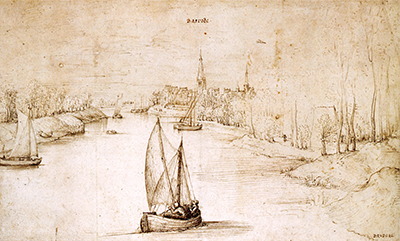This delightful drawing is believed to have been completed by a member of the Bruegel family in around the year of 1600. It is relatively rare in its focus on a river scene, when most of his other drawings were based in the nearby countryside.
There is a likelihood that this piece was put together by Jan Brueghel the Elder, with it following many years after the passing of Pieter the Elder. The family produced a large amount of art along similar lines, stylistically, but there was still room for their own ideas and influences within their respective careers. Attribution has proven tricky with drawings because they were not generally documented at the time particularly well. As such, this drawing has been described as After Pieter Bruegel the Elder, accepting the similarity but also suggesting that most likely it came from the later hand of a relative. Pieter's own son would generate a successful income from making copies of his father's work but he did also produce his own work from time to time.
The composition features a long river with banks on either side, lined by a number of boats. A darker image in the foreground immediately draws our attention to the boat nearest us, which features several people on board. There are then further vessels dotted around in the background, plus a complex arrangement of buildings in a cityscape in the furthest background, close to the centre of the painting. A number of churches and towers pop up into the sky, but the main focus is given to these boats in front of them and the river itself which appears tranquil.
This drawing is owned by the British Museum in central London in the UK. Their entry about it dates the piece at circa 1600, which means they cannot be completely sure of a precise date, but are confident in placing it at around this year. This museum is amongst the most visited art venues in Europe and boasts a wide ranging collection which covers multiple regions and civilisations from right across the world. Whilst they hold a number of old masters' drawings that would be impressive enough on its own, this is very much an establishment which focuses on a much wider audience and a collection that suitably serves it. It differs, therefore, from the likes of the Tate galleries or the National Gallery, where the offering is entirely based on art.




